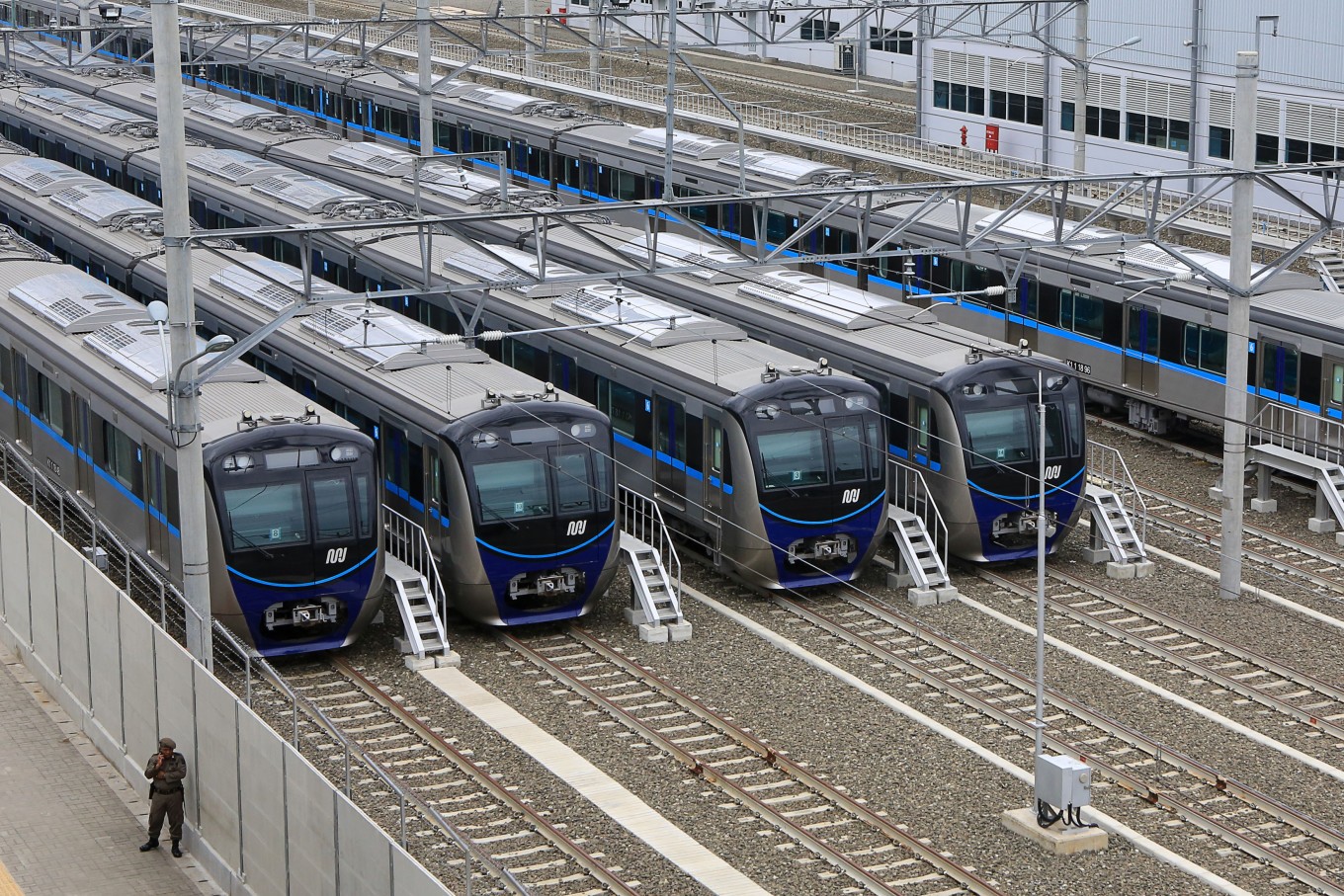Popular Reads
Top Results
Can't find what you're looking for?
View all search resultsPopular Reads
Top Results
Can't find what you're looking for?
View all search resultsKAI, MRT ink deal to establish integrated Greater Jakarta transportation authority
The entity joint venture company will manage public transportation-related aspects, including fares and routes.
Change text size
Gift Premium Articles
to Anyone
 MRT trains are parked at a depot in Lebak Bulus, South Jakarta, in March. State-owned railway operator PT Kereta Api Indonesia (KAI) and city-owned transportation company PT MRT Jakarta signed an agreement on Monday on the establishment of a joint venture company to manage transportation in Greater Jakarta.
(JP/Seto Wardhana)
MRT trains are parked at a depot in Lebak Bulus, South Jakarta, in March. State-owned railway operator PT Kereta Api Indonesia (KAI) and city-owned transportation company PT MRT Jakarta signed an agreement on Monday on the establishment of a joint venture company to manage transportation in Greater Jakarta.
(JP/Seto Wardhana)
I
n a bid to provide better public transportation services, state-owned railway operator PT Kereta Api Indonesia (KAI) and city-owned transportation company PT MRT Jakarta have signed an agreement on the establishment of a joint venture company to manage transportation in Greater Jakarta.
The agreement was signed by KAI president director Edi Sukmoro and MRT Jakarta president director William Sabandar at City Hall, Central Jakarta, on Monday and witnessed by Deputy State-Owned Enterprises (Soes) Minister Kartika Wirjoatmodjo and Jakarta Governor Anies Baswedan.
Earlier this year, central government officials announced that public transportation in Greater Jakarta would be managed under one authority led by the Jakarta administration. The entity will manage public transportation-related aspects, including fares and routes.
The joint venture company will be 51 percent owned by MRT Jakarta and 49 percent by KAI, the parent company of commuter line operator PT Kereta Commuter Indonesia and airport train operator PT Railink.
“The SOE [KAI] is fully committed to supporting the integration of transportation in Jakarta,” Kartika said after the signing.
The joint venture firm will manage all railway stations and develop transit-oriented-development (TOD) planning at designated stations.
“With cooperation in managing stations and TOD, hopefully Jakarta residents will be more interested in using public transportation within two or three years,” he added.
Speaking on the same occasion, Anies said the joint venture should improve the convenience of using public transportation, of which 1 million passengers use railway-based transportation and 980,000 use wheeled vehicles.
“Hence, those who have been using rail-based transportation and wheeled-based transportation will enjoy the integration,” he said.
Kartika said the joint venture company had yet to be named, but it was expected to be fully operational after a month of institutional preparation.
“[Also] one month [preparation] for capital injection," he said. "We will conduct a study on TOD immediately after."
William chimed in by saying the joint venture would spend its first three months preparing for integrated transportation and TOD management planning in the capital.
“We should see real results in the third and fourth quarters of next year,” he said.
He emphasized that integration would include connecting transportation infrastructure.
“Hence [public transportation] will be accessible from one [mode] to another. Passengers getting on and off the MRT, LRT, Transjakarta bus, commuter line, all will be connected,” he said.
Integration will not be limited to infrastructure, but also to ticketing, he added. The firm will conduct a study on the implementation of an integrated electronic fare collection (EFC) system for public transportation modes in the capital.
MRT Jakarta recently received a permit from the Central Bank to issue its own multi-trip tickets. The tickets will be valid for all modes of public transportation in Jakarta by 2022.
As a priority, however, Jakarta Transportation Agency head Syafrin Liputo said the firm would manage several stations considered the most hectic, such as Tanah Abang, Senen, Gondangdia and Juanda, during its early periods of operation.
“Tanah Abang is congested with ride-hailing drivers, so that’s what we will arrange first,” he told reporters after the signing of the agreement.
Greater Jakarta daily passenger numbers increased exponentially from 47.5 million in 2015 to 88 million in 2018.
The Jakarta administration has tried several ways to deal with extreme traffic congestion in the city, which is home to 10 million people at night and more than 14.5 million during the day.
The measures include the expansion of odd-even license plate traffic policy, the commercial operation of MRT Jakarta and LRT Jakarta starting April 1 and Dec. 1, respectively, and the expansion of Transjakarta bus and angkot (public minivan) routes.
The central government has agreed to assist the city administration in boosting its transportation sector through the development of infrastructure, which it refers to as urban regeneration. The projects consist of the MRT, the LRT and the elevated loopline railway network development, along with Transjakarta route expansion and public minivan revitalization. (sau/hpw)









